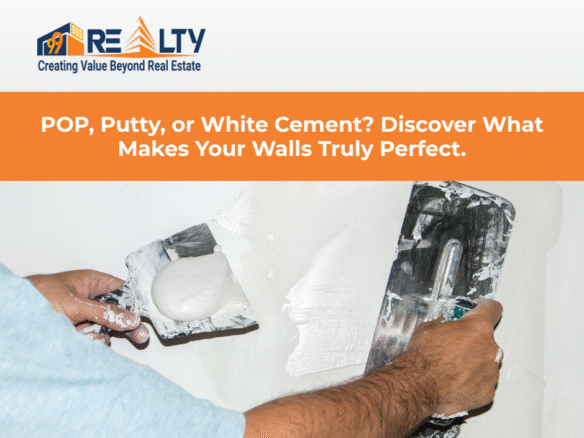Let’s get real — buying a home isn’t all just about Vastu, view, or vibes. It’s about value. And the biggest factor that drives long-term value? Construction quality. In real estate, construction quality isn’t just another factor. It’s the foundation (literally and financially) of your entire investment.
It’s what separates a dream home from a future nightmare. Whether you’re a first-time buyer, an investor, or someone scouting for your family’s forever home, knowing what’s behind those walls is crucial.
Comprehensive Guide to Main Door House Entrance Vaastu in India
Why Construction Quality Should Be Your #1 Concern
The Hidden Cost of Poor Construction
Shiny tiles and modular kitchens can hide a lot of sins. Cracks, seepage, mold, rusted fittings — these are just symptoms of corners being cut during construction. And once these surface, you foot the bill.
Long-Term Impact on Property Value
Properties with better structural integrity:
- Age better
- Appreciate more
- Cost less in maintenance
- And fetch better resale/rental rates
So yes, that “build quality” tag line isn’t just marketing fluff — it’s money in the bank.
Why ‘Construction Quality’ is More Than Just a Buzzword
Hidden Dangers of Poor Construction
It may take years, but poor construction always reveals itself — and not in a good way. You might start noticing:
- Cracks on walls and ceilings
- Water seepage from bathrooms
- Sagging slabs or tiles popping out
- Musty smells from damp corners
Each of these issues points to deeper structural or material flaws. And they’re expensive to fix.
Mivan Construction Technology: Revolutionizing Modern Construction
The Financial Domino Effect
Here’s how poor construction snowballs into bigger costs:
- More frequent repairs
- Higher maintenance bills
- Shorter property life
- Lower resale or rental demand
Think of your home as a long-term asset — cutting corners today could mean bleeding money tomorrow.
What Does “Construction Quality” Actually Mean?
Most buyers only look at the surface. But real construction quality runs deep.
Structural Integrity
This is the skeleton of your home. Beams, columns, slabs, foundations — everything that ensures your building won’t lean like the Tower of Pisa in a few years.
Materials Used
From TMT steel to M20 or M25 grade concrete, from waterproofing chemicals to branded pipes — the materials decide durability, safety, and even energy efficiency.
Workmanship and Finishing
Even top materials fail with poor craftsmanship. Look for things like:
- Neat plastering
- No tile gaps
- Perfectly aligned door frames
- Even paint finish
Good workmanship = fewer repairs = less stress.
5 Signs of Good Construction in Residential Projects
1. Solid Foundation and RCC Structure
Check if the project uses Reinforced Cement Concrete (RCC) with adequate curing time. Ask for details on pile depth or foundation type used in different soil conditions.
2. Even Wall Plastering and Paintwork
Uneven surfaces, flaking paint, or hollow-sounding walls? Red flags. Good quality shows up in finish, symmetry, and strength.
3. High-Quality Fixtures and Fittings
Brands like Jaquar, Hindware, Havells, or Anchor are usually a green flag. Cheap, local fittings wear out fast and invite leaks or fire hazards.
4. Proper Waterproofing & Drainage
Cracks near balconies or ceiling stains in monsoons? Poor waterproofing. A good builder ensures proper slope, drainage systems, and uses chemical sealants where needed.
5. Fire Safety and Emergency Provisions
Does the building have fire alarms, extinguishers, and emergency exits? Are fire-resistant materials used in electrical fittings? Safety first, always.
How to Inspect Construction Quality (Even as a Layman)
Site Visits – What to Look For
Visit during different construction stages if possible. Look at:
- Cement mix ratio
- Curing methods
- Column alignments
- Work cleanliness
- Labor safety practices (they often reflect site discipline)
Ask for BOQ and Material Specs
The Bill of Quantities gives a clear view of what materials and quantities are being used. Don’t hesitate to ask — a transparent builder will gladly share.
Certifications and Compliance Documents
Check for:
- RERA number
- Occupancy Certificate (OC)
- Soil test reports
- Structural audit reports (especially in high-rise buildings)
Don’t just rely on brochures or sample flats — visit the actual construction site (even if it’s mid-phase). Take along a civil engineer or architect for an unbiased, technical opinion. A 30-minute inspection today can save you lakhs in repair tomorrow.
Occupancy vs Completion Certificate : The Ultimate Survival Guide for Indian Homebuyers
Paperwork That Proves Quality: What You Should Ask For
Essential Documents
- Approved Building Plan
- Structural Engineer’s Certificate
- Soil Test Report
- Bill of Quantities (BOQ)
Certificates and Testing Reports
- Concrete cube test results
- Electrical wiring audit
- Waterproofing guarantee
- Occupancy Certificate (OC) after handover
Don’t hesitate to demand these — it’s your right as a buyer.
How Quality Construction Translates to Higher Returns
Longevity & Low Maintenance
Well-built homes age gracefully. You won’t be spending ₹50,000 every year on fixing leakages or repainting.
Better Rental and Resale Value
Buyers and tenants love properties that “just work.” No complaints, no headaches — just clean, livable spaces.
Safety and Comfort for Years to Come
Peace of mind comes from knowing your home is safe — from fire, collapse, or electrical hazards.
Real-Life Construction Issues to Learn From
Balcony Leakages & Seepage Woes
A major problem when waterproofing is skipped or poorly executed. Can lead to fungus, structural rusting, and tenant complaints.
Wall Cracks After a Few Monsoons
Often caused by poor plastering, uneven settlement, or subpar materials. Reduces property’s perceived value dramatically.
Poor Drainage Leading to Dampness
Flat roof? Improper slope? Water collects and eventually seeps inside. Always check rooftop and bathroom drainage quality.
Bonus: 15-Point Construction Quality Checklist for Buyers
| ✅ Checklist Item |
|---|
| RCC structure with M20+ grade concrete |
| Use of branded TMT bars (Fe500/Fe550) |
| Neat brick or AAC block masonry |
| No hollow sound when tapping walls |
| Waterproofing membranes in bathrooms and terraces |
| Proper slope in bathrooms and balconies |
| Fire safety features (alarms/extinguishers) |
| Branded electrical switches and fittings |
| Smooth finishing and aligned door/window frames |
| No visible cracks or gaps in plaster |
| Ventilation and natural light in most rooms |
| Branded Quality of elevator system (if applicable) |
| Functioning plumbing with branded fixtures |
| Proper drains and water outlet provision |
| Site cleanliness and workmanship discipline |
Use this list on your site visit or handover inspection. It’s your ultimate buyer’s toolkit!
Conclusion: Quality is the Foundation of Value
Buying property isn’t just about trends, tiles, or the number of balconies. It’s about trusting what lies beneath — the beams, cement, and effort that makes a house your home.
In today’s market, where so many projects rush toward completion, construction quality is the silent differentiator. It’s what makes your home durable, safe, low-maintenance, and truly valuable over time.
Whether you’re buying for living or investing, make this your mantra: Buy quality, not just space.
Built to Last: A Note from 99 Realty
At 99 Realty, we believe homes should be as strong as your dreams. That’s why we go beyond surface-level beauty — from the depth of our foundations to the brands we trust in your bathrooms, our quality is engineered to last.
From Ranchi’s First Private Swimming Pool Project Swapan Lok to upcoming residential projects, we invite you to experience transparency, commitment, and construction you can count on.
📞 For behind-the-scenes construction updates, site tours our Projects — contact us at 7280000199 or support@99realty.in
Need Help?
Need help evaluating a property or planning your next move in the market?
Reach out to 99 REALTY – your trusted real estate partner for smarter choices.
Subscribe to get updates on our latest posts and market trends.






Join The Discussion